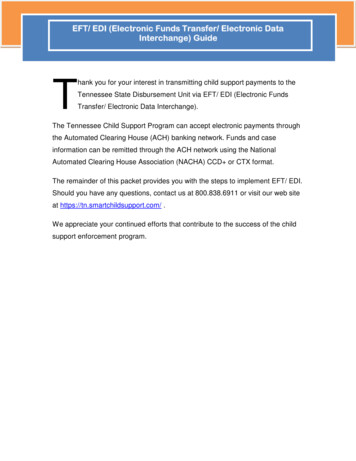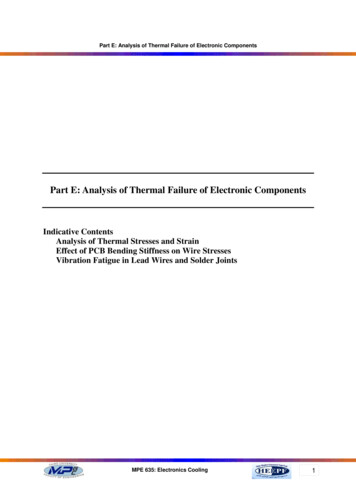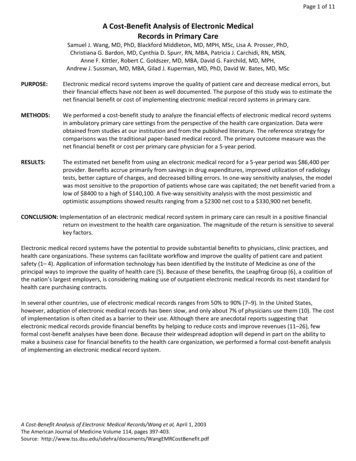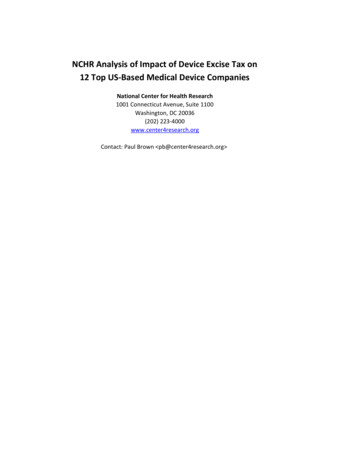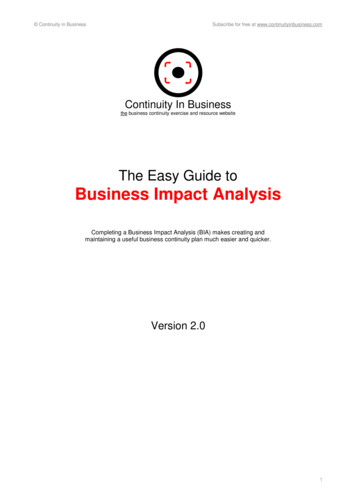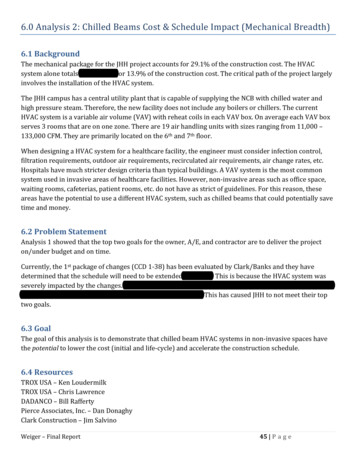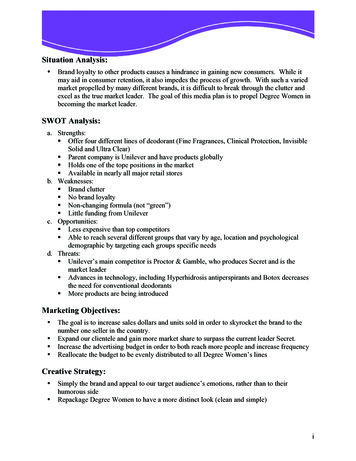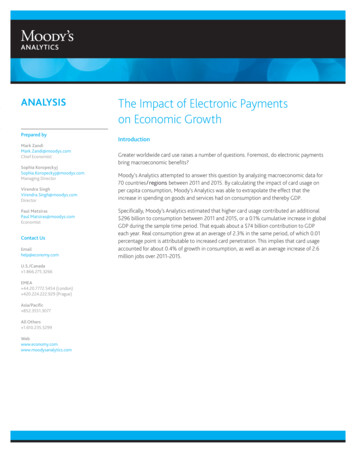
Transcription
ANALYSISPrepared byMark ZandiMark.Zandi@moodys.comChief EconomistSophia KoropeckyjSophia.Koropeckyj@moodys.comManaging DirectorVirendra SinghVirendra.Singh@moodys.comDirectorPaul MatsirasPaul.Matsiras@moodys.comEconomistContact UsEmailhelp@economy.comU.S./Canada 1.866.275.3266EMEA 44.20.7772.5454 (London) 420.224.222.929 (Prague)Asia/Pacific 852.3551.3077All Others s.comThe Impact of Electronic Paymentson Economic GrowthIntroductionGreater worldwide card use raises a number of questions. Foremost, do electronic paymentsbring macroeconomic benefits?Moody’s Analytics attempted to answer this question by analyzing macroeconomic data for70 countries/regions between 2011 and 2015. By calculating the impact of card usage onper capita consumption, Moody’s Analytics was able to extrapolate the effect that theincrease in spending on goods and services had on consumption and thereby GDP.Specifically, Moody’s Analytics estimated that higher card usage contributed an additional 296 billion to consumption between 2011 and 2015, or a 0.1% cumulative increase in globalGDP during the sample time period. That equals about a 74 billion contribution to GDPeach year. Real consumption grew at an average of 2.3% in the same period, of which 0.01percentage point is attributable to increased card penetration. This implies that card usageaccounted for about 0.4% of growth in consumption, as well as an average increase of 2.6million jobs over 2011-2015.
MOODY’S ANALYTICSTable of ContentsExecutive Summary. 1Part I: Introduction: The Macroeconomic Impact of Electronic Payment Usage. 3Part II: The Value of Electronic Payments: Less Friction, More Efficiency. 4Part III: Model Estimation. 6Part IV: Contribution of Card Usage on Consumption and GDP.7Part V: Contribution of Card Usage on Employment.10Part VI: Ongoing Effects on GDP of Greater Card Penetration: Measuring Elasticity by Country.12Part VII: The Evolution of the Report’s Methodology.14Part VIII: Conclusion.15Appendix.162FEBRUARY 2016
MOODY’S ANALYTICSExecutive SummaryRising Card Payments Drive EconomicGrowthPayment cards are not just convenientbut also play a crucial role in stimulating economic growth in countries aroundthe world.Over the last 50 years, the rapid proliferation of electronic payments—in particularcredit, debit and prepaid cards—has changedhow consumers pay for goods and services,how merchants manage their businesses,and how governments make and collect allsorts of payments. Electronic payments provide consumers with convenient and secureaccess to their funds, reduce cash and checkhandling for merchants, and expand the poolof customers who are guaranteed to pay. Importantly, they also promote greater financial inclusion, giving those without accessto the formal banking system an introduction to formal financial services. Electronicpayments also give governments a greaterability to collect additional tax revenue byreducing the number of unreported transactions in the gray economy.All of this reduces friction in the overalleconomy and leads to increased spending ongoods and services. That, in turn, creates avirtuous economic cycle whereby increasedconsumption translates into increasedproduction, more jobs, higher incomes andgreater economic prosperity.But just how much has the expansion ofelectronic payments contributed to globaleconomic growth in recent years? What hasbeen the impact on GDP and employment,and has this impact differed between developed countries and emerging markets?Moody’s Analytics set out to answer thesequestions by examining the impact that themigration toward electronic payments hashad on 70 countries/regions around theglobe over a five-year period between 2011and 2015.1FEBRUARY 2016»The expansion of electronic payments could have a significant,positive effect on future economicgrowth. Across the 70 countries/regions in the study, we found thateach 1% increase in usage of electronicpayments pro-duces, on average, anannual increase of approximately 104billion in the consumption of goods andservices, or a 0.04% increase in GDP,assuming all other factors remain theregions.same.» Countries/regions with the largest» Electronic payments could also haveincreases in card usage experienceda significant improvement onthe biggest contributions to growth.spending habits. Given recent cardFor example big increases in GDP werepenetration rates, growth rates and therecorded in Hungary (0.25%), theadditive effects, Moody’s AnalyticsUnited Arab Emirates (0.23%), Chilecalculated that consumption was 0.4%(0.23%), Ireland (0.2%), Polandhigher between 2011 and 2015 than it(0.19%) and Australia (0.19%). In mostwould have been if electronic paymentscountries/regions, card usage increasedhad not increased; total consumptionregardless of economic performance.increased on average by 2.3% over theOnly in the case of Finland, Greece andsample period. Because consumptionTunisia did card usage decline whengrowth is on average faster in emergingeconomic performance deterio-rated oreconomies, emerging economies haveother macro events affected activity. Asmore to gain by increasing electronica result, consumption was weaker thanpayments usage to speed consump-tionit would have been had card penetrationgrowth even further. Consumptionincreased or remained unchanged.growth in both emerging economies» Increased electronic paymentsand developed countries/regionsresulted in roughly the same perbenefits from additional card usage.This study marks the third time thatcentage increase in GDP between 2011Moody’s Analytics has conducted thisand 2015 for emerging marketsanalysis and the results suggest again that(0.11%) as for developed countriesboth emerging economies and developed(0.08%). However, when card usagecountries/regions benefit from increasingincreases by 1% across countries/electronic payments. However, penetrationregions, developed countries/regionsin and of itself will not necessarily spurexperience a larger percentage increasegrowth. Successful penetration goes hand inin GDP (0.04%) than do emergingmarkets (0.02%). This suggests there is a hand with a well-developed financial systemand a healthy economy.compounding benefit for advancedThis study found that developed countries/countries/regions as electronicregions had a larger dollar increase in GDPpayments usage deepens.Together, these economies make up almost95% of world gross domestic product. Overall, Moody’s Analytics found that:» Electronic payments added 296billion in real (U.S.) dollars to GDP inthe 70 countries/regions studiedbetween 2011 and 2015. That isequivalent to the creation of about 2.6million jobs on average per year over thefive-year period, or about 0.4% of totalem-ployment in the 70 countries/
MOODY’S ANALYTICSthan did emerging markets. On a cautionarynote, slippage in electronic payments usage,such as that seen in Finland and Greece, isestimated to have reduced the resilience ofconsumer spending in these countries/regions to the downturn in their economies.While this study provides a comprehensive look at the impact of electronic payments on economic growth between 2011and 2015, it does not consider as exogenousvariables in our model a country’s fiscal policies nor the strength of a country’s financialsystem such as the stability of the bankingsector or prevalence of financial infrastructure such as ATMs. The study also does notanalyze the effects of mobile phone payments—such as payments through cell phoneapps, which are not directly tied to a credit,debit or prepaid card—which through widespread usage in emerging markets could increase penetration rates. That is, if anything,for emerging markets, the positive impact ofelectronic payments is conservative and potentially an underestimate. Still, the findingsdefinitively highlight the important contribu-2FEBRUARY 2016tion that migration to electronic paymentshas made on economic growth and suggestthat policies that speed card adoption wouldbenefit economic growth across the globe.The report is structured as follows: PartI provides an introduction to the report andbriefly highlights the findings. Part II will discuss the various channels in which electronicpayments usage can help the macroeconomy. Part III will discuss the methodology andprovide an econometric model capturing theeffects of card usage. Part IV will calculateand analyze the additional consumption andGDP brought about by rising card usage. PartV will analyze labor productivity and calculate the increase in jobs due to increases incard use. Part VI poses a hypothetical question to calculate the elasticity of electronicpayments usage on consumption. Part VIIoutlines the evolution of the methodologybetween this and previous versions of thisstudy. Part VIII concludes that there aresignificant economic gains to increased electronic payments penetration and thus thereare also policy implications for governments.Study MethodologyThis study focused on the impact ofincreased card penetration on real privateconsumption in 70 countries/regions overfive years between 2011 and 2015. Theresults were then extrapolated to estimatethe impact that increased consumption hadon eco-nomic output, as measured by GDP,and on job creation.Real private consumption was modeledas a function of real disposable income, realinterest rates and card penetration, defined asspending using credit, debit and prepaid cardsas a share of overall consumer expenditures.The data were pooled for all countries/regions to create a data set with over 325observations; a statistical technique called“pooled cross-section time series estimation”was used to estimate the model parameters.Once the model was specified, this studycalculated various measures to isolate theimpact of card use on consumption, labor andGDP. To isolate the impact of usage, thechange in card penetration between 2011 and2015 was used.
MOODY’S ANALYTICSPart I: Introduction: The MacroeconomicImpact of Electronic Payment UsageSixty years ago, most consumers usedcash or checks to buy goods and services,with cash predominately used for smallerpurchases and checks for more costlytransactions. While cash remains the predominate form of payment in some placesin the world, it has become a less commonmethod of transaction as the advent ofgeneral purpose payment cards has allowedconsumers and businesses to buy and sellwith greater convenience. Today, consumerscan make electronic payments with credit,debit and prepaid cards—and more recently,using all kinds of devices, from watches tomobile phones.Greater worldwide card use raises a number of questions. Foremost, do electronicpayments bring macroeconomic benefits?Moody’s Analytics attempted to answerthis question by analyzing macroeconomicdata for 70 countries/regions between2011 and 2015. By calculating the impact ofcard usage on per capita consumption,Moody’s Analytics was able to extrapolatethe ef-fect that the increase in spending on goodsand services had on consumption andthereby GDP.Specifically, Moody’s Analytics estimatedthat higher card usage contributed an additional 296 billion to consumption between2011 and 2015, or a 0.1% cumulative increase in global GDP during the sample timeperiod. That equals about a 74 billion contribution to GDP each year. Real consumption grew at an average of 2.3% in the sameperiod, of which 0.01 percentage point is attributable to increased card penetration. Thisimplies that card usage accounted for about0.4% of growth in consumption, as well asan average increase of 2.6 million jobs over2011-2015.The impact of card usage on consumption and economic growth varied considerably across the 70 countries/regions thatwere studied. This reflects differingeconomic growth rates, penetration, andfinancial systems. Financial systemsconducive to the growth in electronicpayments include control overEconomy Averagecontribution to GDP0.10%3FEBRUARY 2016inflation and themoney supply, awide network ofstable and readily accessiblebanks, insurancecompanies andpension funds, theexistence of markets such as stockexchanges, andthe availabilityof such financialinfrastructure as ATMs. Card usage increasedconsumption the most in Russia (0.64%),the United Arab Emirates (0.52%), Qatar(0.47%), Ireland (0.42%), and Hungary(0.4%). Card penetration rates increased byover 7 percentage points in each of thesecountries between 2011 and 2015.Declining card usage decreasedconsump-tion by 0.003% in Greece and0.04% in Finland. Severe recessions in bothcountries during the time period in additionto higher tax rates likely led to decreasedcard usage.Additionally, the report includes a hypothetical study of the impact of a 1% increaseper year in the card penetration rate in eachcountry/region. Every 1% increase in cardusage across the 70 countries/regionsproduces an annual increase ofapproximately 104 billion in theconsumption of goods and services, or a0.04% increase in GDP, assuming all otherfactors remain the same.The estimated GDP elasticity, or responsiveness of GDP to increases in card penetration, for developed countries/regions ishigher than it is for emerging markets,because the card penetration rate is nearlythree times the size for developedcountries/regions, where it averagesalmost 42%, as it is for emergingeconomies, where penetration averages16%. This is not surprising considering thatdeveloped countries/regions are placesthat have more established paymentnetworks, con-sumers who are morecomfortable using cards, and environmentswhere cards are ac-cepted by mostmerchants. By comparison, cash paymentsare still more prevalent in emergingeconomies.
MOODY’S ANALYTICSPart II: The Value of Electronic Payments:Less Friction, More EfficiencyElectronic Payments Benefit All PartiesInvolved in Many WaysWithin the electronic payments ecosystem there are two main end-parties: buyers(consumers) and sellers (merchants). Theevolution to electronic payments from cashand checks has changed the behavior of, andin some cases the relationship between, consumers and merchants.The availability of electronic paymentsystems leads to a virtuous economiccycle whereby increased consumptionleads to increased production, more jobs,greater income, and, ultimately, strongereconomic growth.Although the study does not specificallyexplore the reasons for the incrementalgrowth in GDP attributable to card usage,there are a number of plausible explanations: The advent of electronic payments hasgreatly aided consumers’ ability to optimizeconsumption decisions by giving them secureand immediate access to all of their funds ondeposit (debit cards) or a line of credit (creditcards). Merchants also benefit because thereConsumptionis less cash and check handling in the system,and they have access to a large pool of customers with guaranteed payment. Electronicpayments play a critical role in the rapidlyexpanding e-commerce environment wherepayment by cash or check is not usuallyan option.Benefits to Consumers and Merchants»Electronic payments provide accessto financial resources. Consumersusing cash or checks may be limitedin the amount of funds they have forparticular transactions. With cash,consumers are limited to the fundsthey have on hand. Merchants maybe reluctant to accept checks for bigger transactions because of the riskof nonpayment. Electronic paymentsaddress both of these issues: Theyprovide consumers with access to allavailable funds or lines of credit for agiven transaction and they give merchants peace of mind about paymentDecline in InventoryGreater Income4FEBRUARY 2016»»guarantees, provided they follow appropriate payment procedures.Access to credit helps calibrateperiodic income with continuousconsumption. Wages and salariesare typically paid weekly, biweekly ormonthly. Consumer spending, however, has no time profile. Putting foodon the table or fixing a broken-downvehicle should not have to wait forthe next paycheck. Credit smoothsout the consumption of durable andnondurable goods by lessening theneed to wait for paydays. In obtaining credit, consumers generally havethree options: bank loans, store creditor credit cards. Credit cards are moreconvenient and offer lower consumertransaction costs, as the former twoinvolve paperwork, hassle and a potential transaction-by-transactionwaiting period.Cards provide consumers the meansto participate in the digital economy. In most cases, online shoppers areIncreased ProductionMore Jobs
MOODY’S ANALYTICSrequired to use cards for purchases.Cardholders thereby have a larger variety of goods and vendors to choosefrom and a broader internationalmarketplace is made available to consumers. Opportunities are limited forconsumers using cash. Since onlineshopping is also completed with “theclick of a button,” the economy immediately receives a jolt to consumptionand GDP.Security»5Trust in electronic transactionsfurther drives consumption. Withelectronic payments, consumers haverecourse for fraudulent transactions.The peace of mind that merchantshave with guaranteed payment alsoextends to consumers, who feel morecomfortable making purchases whenFEBRUARY 2016they can pay with a card. This trust inthe payment system eases friction,bolstering consumption and therebyGDP growth.Transparency»Convenience»Cards provide convenience and lower business costs. Consumers cite theconvenience of electronic payments,whether it means not having to visitthe ATM to obtain cash or not havingto count out the cash at the point oftransaction. This convenience benefitsmerchants as well. For instance, whenconsumers use their own cards at theself-service gasoline pump or supermarket, it lowers labor costs for merchants. Each small portion of frictionthat electronic payments eliminatefrom the system contributes to higherconsumption and GDP.»Electronic payments reduce centralbank costs in providing currency. Byreducing paper transactions, electronicpayments can reduce the cost to central banks of providing notes and coinsor to Treasury or Finance departmentsof processing paper money, therebyimproving overall efficiency in commerce and the economy.Electronic transactions eliminatea substantial portion of the grayeconomy. Retailers who do not report some or all of their transactionsto avoid paying certain taxes usuallyprefer cash transactions. Electronictransactions, on the other hand,are “above board” and create anaudit trail that greatly reduces unreported transactions, thereby raisingtax revenues.
MOODY’S ANALYTICSPart III: Model EstimationElectronic Payments, PrivateConsumption and GDPThe level of consumption and card usageis highly correlated. Consumers indeveloped countries/regions with morerobust card infrastruc-ture have theopportunity to use cards more often than inemerging markets. A natural question is:How much does greater card usage or cardpenetration contribute to con
regions, developed countries/regions experience a larger percentage increase in GDP (0.04%) than do emerging markets (0.02%). This suggests there is a compounding benefit for advanced countries/regions as electronic payments usage deepens. » The expansion of elec tronic pay-ments could have

